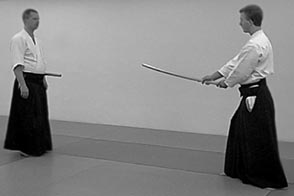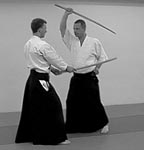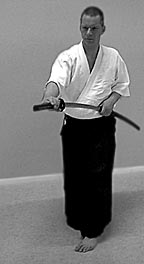The
Iaido Journal Aug 2001
A sword for the aikidoka:
Choices made in constructing the Aiki Batto
by Stefan Stenudd
Copyright Stefan Stenudd © 2001. All rights reserved.
What is needed?
So what is needed of a sword exercise system? The question cannot be
answered without first deciding what should be learned from it. A basic
understanding of the traditional Japanese sword arts, is a self-evident
first, but for me as an aikido teacher, I would have to add that this understanding
and its applications should be in the framework of aikido’s principles
and strategy.
A sword art, then, for the aikidoka.
That is a risky business indeed. When trying to apply the sword to aikido
concepts, one might easily happen to substitute the functional with something
else, which might look good and feel fine, but lacks essentials for the
sword to be handled according to its own terms - which are in some cases
just as sharp as its edge.
One needs to be systematic, especially in deciding what should be learned.
When I constructed the Aiki Batto exercise system, I found it helpful to
think along two lines of demands - those of the sword arts, and those of
aikido.
Sword art demands

The sword art related demands I would like to see as suburi needs on
one hand, and a general understanding of sword strategy on the other. Suburi,
then, includes such fundamentals as posture, how to grip the sword, and
of course how to cut with it - elements that take a lifetime, nothing less,
to adapt properly.
Having practiced with the sword for more than a quarter century, I still
experience little revelations now and then, when it comes to gripping the
sword, or raising it to jodan kamae, not to mention doing a cut, a thrust,
a parry. Nothing but practice, year after year, can bring on a refinement
in these details.
But this practice, with repetition and a certain monotony being essential
to it, still has to be done in a spirit of curiosity, inspiration, delight
- or not much will be learned from it. I don’t believe suburi is doing
its job optimally, when the students find it boring. So, I knew I would
have to make suburi a substantial part of the exercise system, but disguise
it, not to strike the students as terribly predictable and dull, like some
household chores.

Regarding the strategy of the sword, I simply refer to such things
as rhythm or timing, and how to move the sword from one position to the
next, how to meet different attacks, how to position oneself in relation
to the opponent, etcetera. This cannot be completely understood in solo
kata practice alone - one has to be able to try it out with a partner.
Still, the solo exercise is necessary as well. Without it, the students
will have great difficulties in experiencing the demands of the sword itself
- how it can be moved swiftly, and how not, how to cut with it, and how
not to cut oneself in the process. Mainly, the solo kata training establishes
the necessary link, one might even call it bondage, between the student
and the sword. They should learn to act as one, and without solo training,
I do not think it can be accomplished.
So, the sword art aspects demanded that my exercise system contain a
lot of suburi, but disguised in different combinations of movement, and
to be trained both solo and with a partner.
Aikido demands
In aikido the partner exercises are central - solo training is both
rare and peripheral - so a sword system without partner training would
be alienating to the aikidoka. A tori and uke exchange is the path, the
source and the solution. Two centers interacting, to the point of becoming
one.
Nevertheless, at the outset there are two centers, which should be clearly
defined. In the partner training of aikido, this is sometimes neglected,
so that the two intermingle and adapt to each other, until there is no
longer a difference between tori and uke - a situation of quite some philosophical
beauty, no doubt, but if not reached the long way, I do not believe it
speaks true budo.

So, the aikidoka needs some aspects of training which have a clear
solo exercise ingredient. The sword art is evidently very suitable for
this.
Still, if the strategy of aikido is to be respected, the movements have
to be constructed in such a way, that they conform to this particular strategy.
Allow me to pinpoint the most essential elements of it, which seem to be
suitable to express in the negative: no attack but only defense, no resisting
or blocking of attacks, no need of superior force, no halting of the flow
of the movement.
Much of this is, of course, incorporated in other Martial Arts as well,
but the aikido strategy is an uncompromising focus on it.
Four negatives needed
‘No attack’ means waiting for the opponent to charge, before
taking any action. In the Aiki Batto (as in iaido) this is stressed by
tori starting with the sword still in the scabbard, not drawing it until
the attack commences. The more common starting position in aikiken, that
of chudan kamae against the same guard, seems to me not to be the optimal
aikido attitude. It also creates the strategic problem of uke not being
able to withdraw from kamae, without feeling a risk of easily being struck
by tori.
‘No resisting’ means stepping out of the way of the attack, so
that it can be completed - of course without the defender being hit by
it. This is in aikido done by the taisabaki body move, usually forward
to the side. For suburi purposes, this also has the advantage of uke not
having to stop the cutting move prematurely - in Aiki Batto uke is mostly
exercising little else than the straight cut, the fundament of the sword
arts.
‘No superior force’ means that the counter moves should be done
in openings caused by the original attack, and not by maneuvers which demand
of tori to have superior speed or power. In budo it is discovered that
the attacker cannot avoid creating openings for the defender to exploit
- that is, if the initial attack was not successful. This pacifying circumstance
is just as true also in a second or third attack, wherefore I did not introduce
any exchange of charges in the shoden exercises of the Aiki Batto - no
tori blows blocked or otherwise avoided by uke. That would have dimmed
the understanding of this rhythm - the shortcut available to the one not
attacking. That is also why all the counter techniques are done either
at the same time as the attacks, or immediately following them. In the
so called okuden set of exercises, though, I plan to include some fencing,
where both tori and uke have their strikes avoided by the opponent.
‘No halting of the flow’ means that the counter moves should
be performed so that they do not stop the attack but rather “complete”
it, or make the attacker continue in the direction initiated by his or
her attack. Again, this is important for uke to be able to exercise proper
attacking techniques fully, but more importantly, this is a sort of economy
of battle, which is central to aikido thinking. Few things are of such
help in getting an advantage in the duel, as the ability to extend the
attacker’s moves beyond their initial aim - causing uke to lose both time
and balance. But it takes, as Musashi would put it, a lot of training to
accomplish.
In my next article, I would like to elaborate on how the above principles
have influenced the design of the ten Aiki Batto shoden exercises.
Stefan Stenudd started studying aikido in 1972, at age 18. He
currently holds the grade of 5 dan Aikikai (1997), shidoin, and 4 dan iaido
(1996) of the Aikido Toho Iai Kenkyukai. He is past chairman of the Swedish
Budo Federation Kendo section in the early 80's, and its Aikido section
in 1989-91 and again 1995-99. He is the author of several books and articles
including the Swedish translation of Go Rin no Sho. He formed the
publishing house Arriba in 1985, with books mainly about Far East philosophy
and Martial arts. His website can be found at: http://www.stenudd.com/


